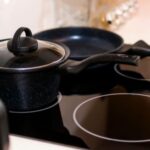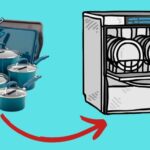Best Cookware With Riveted Handle – [Compete Guide]
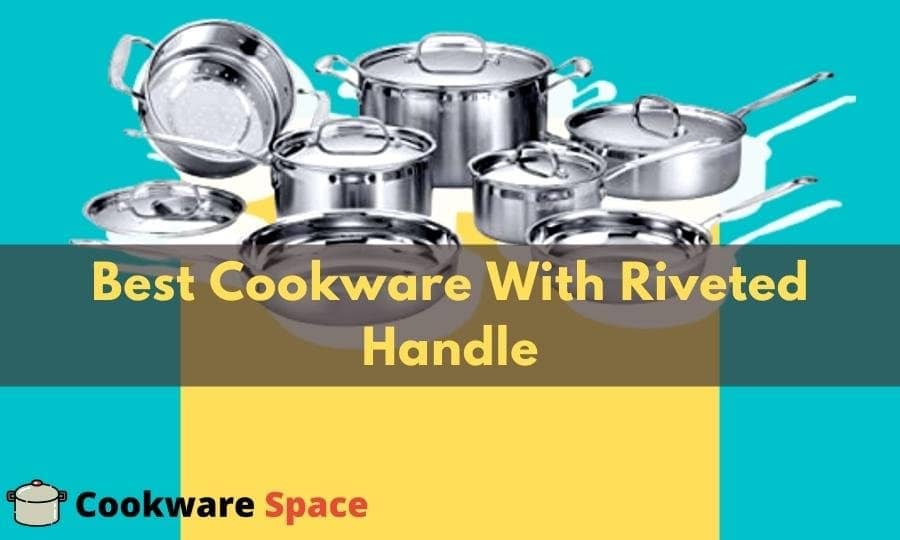
Whenever you want to buy cookware, make sure that it is sturdy and durable. The handles are an essential thing to look at when selecting cookware. It’s better to choose the best cookware with riveted handle. The riveted handles give additional strength to the pots and pans.
The top cookware brands make heavy-duty cookware with riveted handle for sturdiness. The only thing you should look at is the quality of rivets, better the quality durable the cookware will be.
Types of handles
Rivets:
Rivets are small metal pieces used to attach handles to the pots and pans. Rivets strongly join the handles to the cookware and make it durable and lasting for years. Rivets are used in all types of cookware i.e. budget, mid-range, and luxury.
In many cookware nowadays, rivets are mostly used as a tool for attaching handles. Rivets can be made up of any metal but usually cookware manufacturers use steel or aluminum rivets.
Welds:
Welds are made by melting the separate pieces of metal to join them together. It melts the base material and adds a filler material at the joint of two metals to create a strong bond. Different energy sources like gas flame, an electron beam, laser, friction, ultrasound, and electric arc are used for welding.
Screws:
Screws are used to fasten the handle to pots and pans. The screws are used in cheaper cookware mostly. Some home chefs prefer the screwed handles because if the screw looses, they can conveniently tight it by themselves. You can also replace the screw if it rusts over time. So, it’s better than welds, brazing, and rivets only in this respect that it can be changed.
Brazing:
Brazing is a process of joining two pieces of metals by melting and heating the filler and creating a bond. The filler must have a lower temperature than base materials. Brazing is different from welding because welding joins the same metals but brazing is better at joining different metals together.
What is the difference between welded and riveted handle cookware?
The difference between welded and riveted handle cookware is the method used to attach the handle.
Riveted handles are attached to a pan’s body by means of metal rivets, whereas welded handles are created with a partial fusion of the materials from which the pan is made.
Rivets vs welds: Why to choose cookware with a riveted handle?
Riveted are considered better than welds for security purposes. If the rivets get loose, you’ll be having an idea of its breakage in the near future. On the other hand, welds can break all of a sudden and can cause any sort of disaster. Think for a while what will happen if the welds break when manoeuvring the pot full of hot sauce?
The material of cookware also determines the use of rivets or welds. The aluminum and copper cookware is mostly riveted for the reason they don’t soften or melt easily like stainless steel. The lovers of aluminum or copper should prefer cookware with riveted handles as compared to welded handles.
The best cookware with riveted handles will be durable when rivets are of high quality. The cheap material rivets are of no use just like cheap welds.
Rivets and welds both are good at their own but professionals opt the cookware with riveted handles. It’s up to you which one you like the most but cookware with riveted handles will be workable for many years to come.
List of high Quality Cookware Set with Riveted Handles
1- Cuisinart Multiclad Pro Stainless Steel Riveted Handles Cookware Set
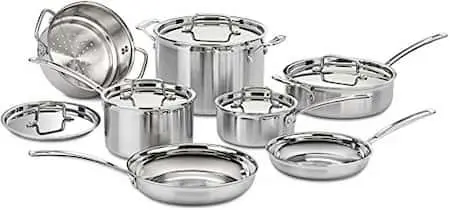
The Cuisinart Multiclad Pro is attractive cookware with mirror-polished interiors and brushed finish exteriors. The polished interior is non-reactive to the food and never changes its flavor to provide you healthy food.
The stainless steel riveted handles stay cool on the stovetop and provide a secure grip. The Cuisinart Multiclad Pro is a 12 piece set that contains all the best cooking pans and pots required for daily cooking.
Use this cookware without any fear on your induction cooktop. The drip-free pouring rims keep you secure and your kitchen clean. Heat surround technology makes your cooking easy by providing even heat to the bottom and sidewalls of pots and pans.
2- T-fal Ultimate Stainless Steel Copper Bottom Riveted Handles Cookware Set
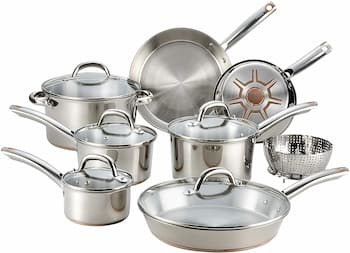
The multi-layers of copper, stainless steel, and aluminum provide the basis for even and faster heat distribution. What experts like the most about this cookware is that stains never left over the bottom to make cleaning an issue. After preheating, only a thin coating of cooking oil is required to avoid sticking of food.
The heavy-gauge base made up of stainless steel with copper bottom makes the heat flow smooth from the center to the sides. It satisfies all the home cooks by flawless performance and high durability. So you can call it best stainless steel cookware.
When having cookware that is dishwasher safe then you should never worry about the cleaning issues. Up to 500 degrees F, this cookware can be placed in an oven for making fantastic dishes.
Interior measuring marks will make the filling of water easy and convenient. Enjoy your cooking in T-fal 13 piece cookware set fearlessly because it has a limited lifetime warranty.
3- Calphalon Simply, 10 piece Cookware Set
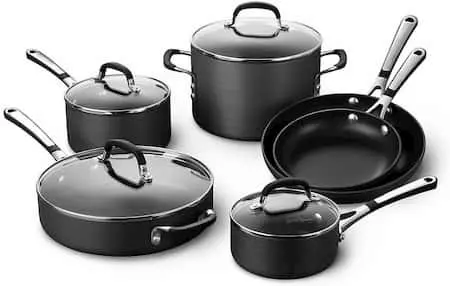
Are you a nonstick cookware lover? The Calphalon 10 piece cookware set is remarkable cookware with two nonstick layers. The nonstick layers make cleaning easy because food doesn’t stick to the surface of the cookware.
Simply Calphalon cookware has a medium gauge that makes the cookware sturdy so, it will never warp or dent. For improved and better cooking even heating is required.
This cookware is constructed from heavy-duty hard-anodized aluminum and is anti-corrosion. The tempered glass covers allow you to keep an eye on the cooking material. Moreover, the glass lids will retain natural flavors and needed moisture inside the pan for incredible cooking results. The heat resistant and comfortable handles provide a secure grip over pots and pans. It is recommended to wash the cookware by hand with soap and water.
4– Duxtop Professional 17 Pieces Stainless Steel Induction Cookware Set
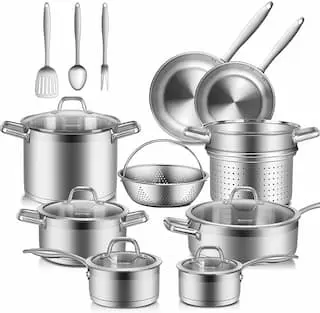
The Duxtop SSIB-17 cookware has versatile and useful pots and pans compatible with all cooktops including induction. For efficient and incredible cooking, buy this stainless steel cookware with impact-bonded heavy gauge bottom. The aluminum impact-bonded bottom lasts long to provide the amazing cooking results.
Handles are always considered an essential part of the cookware. The satin-finished and riveted handles are making this cookware durable.that’s why it is best cookware with riveted handle. You’ll never feel the handles slipping from your hands.
The cookware will make you love it by its various qualities. The measuring marks inside the pots allow you to put the required water conveniently. Store the remaining food in the freezer and use it in the oven up to 550 degrees F, it’s better in all aspects. The 3-piece kitchen tools are also added in a 17-piece cookware set.
5- Fleischer & Wolf White nonstick cookware set
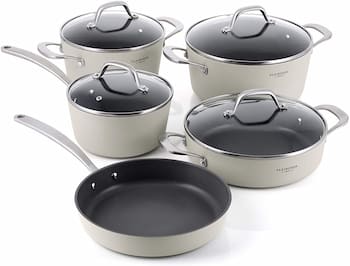
Fleischer & Wolf White cookware set is having 9 very useful pieces. The cookware is constructed of aluminum and stainless steel for higher durability. Everyday you will enjoy your cooking experience with this superb cookware.
People having induction cooktops have a very limited choice in cookware because all cooking vessels are not suitable for every stovetop. Keep this cookware every time in the oven without any fear because it can bear 550F temperature.
The thickness of cookware is 4.7mm that makes it highly robust and durable. The riveted stainless steel handles are providing extra sturdiness to the cookware.
The hard oxidized process and flame-resistant outer coating make an exceptional exterior. The nonstick interior is better at cooking different recipes perfectly.
Frequently Asked Questions
What are rivets made of?
Rivets are generally made from the same materials that pots and pans are made with.
Do riveted stainless steel handles get hot?
The answer is no, not really. It is true that stainless steel will heat up when exposed to heat, but riveted handles are actually a little more insulated than welded handles. Although a riveted handle will get a little warm after being exposed to the stove’s flame for an extended period of time, they generally do not produce enough heat to be considered hazardous.
Why do pans have rivets?
Pans have rivets because rivets are a good way to attach handles, and it is the most common method used in cookware design. Another reason is cleaning become easy since there are no gaps around the handle to hide grime. And lastly, riveted handles are typically made from durable materials that will not melt or deform at high temperatures.
What are the benefits of riveted handles?
For one, rivet-attached handles are generally more secure than welded handles, because rivets are generally made from durable, heat resistant materials like copper and aluminum, whereas welds can be weaker and more susceptible to melting.
What materials are welded handles made out of?
Welded handle cookware is generally made from cast aluminum, stainless steel, or copper materials that have been fused together at extremely high temperatures. While there can be slight variations in the materials used for various types of cookware, this tends to be the common material composition.



